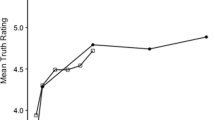Abstract
We revisit the result that, in laboratory independent private values auction, the first-price sealed bid and descending clock (or Dutch) implementations are not isomorphic. We investigate the hypothesis that this arises from framing and presentation effects. Our design focuses on a careful construction of subject interfaces that present the two environments as similarly as possible. Our sessions also consist of more auction periods to test whether any initial framing effects subsequently decrease over time. We find the difference between the implementations persists. To further investigate the difference, we report on an intermediate implementation which operates like the Dutch auction, but in which the clock continues to tick to the lowest price without informing bidders when others have bid on the object.
Similar content being viewed by others
References
Cason, T. N., & Friedman, D. (1997). Price formation in single call markets. Econometrica, 65, 311–345
Cooper, A., & Reimann, R. (2003). About Face 2.0: The essentials of Interaction Design. Indianapolis: Wiley
Coppinger, V. M., Smith, V. L., & Titus, J. A. (1980). Incentives and behavior in English, Dutch, and sealed-bid auctions. Economic Inquiry, 18, 1–22
Cox, J. C., Roberson, B., & Smith, V. L. (1982). Theory and behavior of single object auctions. In Smith V. L. (Ed.), Research in Experimental Economics, Volume 2. Greenwich CT: JAI Press
Cox, J. C., Smith, V. L., & Walker, J. M. (1988). Theory and individual behavior of first-price auctions. Journal of Risk and Uncertainty, 1(1), 61–99
Dorsey, R., & Razzolini, L. (2003). Explaining overbidding in first price auctions using controlled lotteries. Experimental Economics, 6, 123–140
Gode, D., & Sunder, S. (1993). Allocative efficiency of markets with zero intelligence (ZI) traders: Market as a partial substitute for individual rationality. Journal of Political Economy, 101, 119–137
Kagel, J. H. (1995). Auctions: A survey of experimental research. In J. H. Kagel & A. E. Roth (Eds.), The Handbook of Experimental Economics. Princeton NJ: Princeton University Press
Katok, E., & Kwasnica, T. (2003). Time is money: The effect of clock speed on seller’s revenue in Dutch auctions. Penn State University working paper
Selten, R., & Buchta, J. (1998). Experimental sealed bid first price auctions with directly observed bid functions. In D. Budescu, I. Erev, & R. Zwick (Eds.), Games and Human Behavior: Essays in honor of Amnon Rapoport. Erlaaum Ass
Smith, V. L. (1982). Microeconomic systems as an experimental science. American Economic Review, 72, 923–955.
Author information
Authors and Affiliations
Corresponding author
Additional information
JEL Classification D44, C90
Deceased
Rights and permissions
About this article
Cite this article
Turocy, T.L., Watson, E. & Battalio, R.C. Framing the first-price auction. Exp Econ 10, 37–51 (2007). https://doi.org/10.1007/s10683-006-9130-4
Received:
Revised:
Accepted:
Published:
Issue Date:
DOI: https://doi.org/10.1007/s10683-006-9130-4




